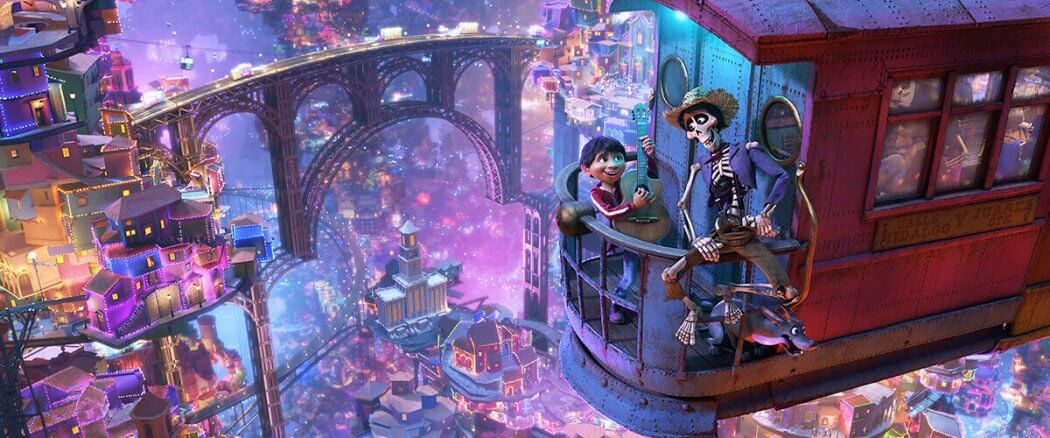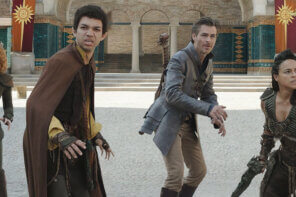Pixar’s latest is a masterpiece of animation and storytelling with it’s characteristic warmth and humor wrapped in a no-cliches, culturally-specific narrative. The story takes place in Mexico, features an all-Latino cast, fluidly switches between Spanish and English, and introduces cultural elements that will be unfamiliar to white audiences — often with no narrative explanation. In Pixar’s 2012 movie Brave (set in the Scottish highlands), we’re also immersed in a foreign culture, but most white movie-goers have at least a passing familiarity with bagpipes, tapestries, will-o-the-wisps, kilts and haggis jokes to understand the references. From the richness of son Mexicano to animated papel picado to ofrendas and alebrijes, the beauty and depth of Mexican culture is on full display. Coco is the story of 12-year old Miguel (Anthony Gonzales), an aspiring musician in a family where music has been banned for generations. During a Dia de los Muertos celebration, Miguel finds himself transported to the Land of the Dead where he enlists the help of calaca Hector (Gael García Bernal) to get him home. It is uniquely Mexican, but this coming-of-age tale is the perfect holiday film for families no matter their ethnic background.
The Other Holiday Movie
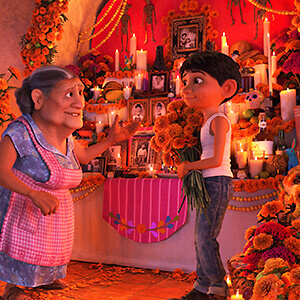 Dia de los Muertos (Day of the Dead) is a Mexican celebration of the dead. It is syncretically Christian in that it combines indigenous religion and practice (all cultures venerate ancestors in one way or another) with Roman Catholic liturgy (it aligns with All Hallows’ Eve, All Saints’ Day and All Souls’ Day). Sadly, it’s also becoming acculturated in America as another way for Target to sell Chinese goods and for White people to come up with sexy costumes and themed drinking parties. Guess what: It’s not the same as Halloween! Calacas are not zombies! In modern Mexico, Dia de los Muertos is a national holiday and is one of their most important traditions. Public schools and government offices alike celebrate the days, making their own ofrendas (altars) featuring pictures of the dead along with favorite food items and other small objects. Can Coco become a holiday movie for today’s families? In Mexico it has already become the most successful film of all time. There are 35 million people of Mexican descent in America, so it looks like the 21st century immigrant experience is mirroring the 19th century’s: ethnic groups introduce their unique celebrations into the American experiment and they either get assimilated or remain on the margins (when’s the last time you saw Chinese New Year gear at Target?). After all, Halloween was once relegated to Irish and Scottish immigrant communities.
Dia de los Muertos (Day of the Dead) is a Mexican celebration of the dead. It is syncretically Christian in that it combines indigenous religion and practice (all cultures venerate ancestors in one way or another) with Roman Catholic liturgy (it aligns with All Hallows’ Eve, All Saints’ Day and All Souls’ Day). Sadly, it’s also becoming acculturated in America as another way for Target to sell Chinese goods and for White people to come up with sexy costumes and themed drinking parties. Guess what: It’s not the same as Halloween! Calacas are not zombies! In modern Mexico, Dia de los Muertos is a national holiday and is one of their most important traditions. Public schools and government offices alike celebrate the days, making their own ofrendas (altars) featuring pictures of the dead along with favorite food items and other small objects. Can Coco become a holiday movie for today’s families? In Mexico it has already become the most successful film of all time. There are 35 million people of Mexican descent in America, so it looks like the 21st century immigrant experience is mirroring the 19th century’s: ethnic groups introduce their unique celebrations into the American experiment and they either get assimilated or remain on the margins (when’s the last time you saw Chinese New Year gear at Target?). After all, Halloween was once relegated to Irish and Scottish immigrant communities.
La Memoria
The holiday is a framing device for the main message of Coco: family is an organism comprised of living and dead members — and all should be remembered and honored.
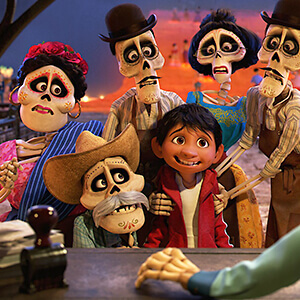 Mama Coco (Ana Ofelia Murguía) is the eldest member of Miguel’s family: his 90-something great-great-grandmother. Confined to a wheelchair and unresponsive most of the time, Coco’s memory is the key to answering a disturbing question in the film: what happens to the dead when there’s no one left to remember them? In the Coco mythology the dead “die” again. In one sad scene, Chicharrón (Edward James Olmos), a dying skeleton, is serenaded in to his after-afterlife (the greater beyond?) as the last living person forgets him. The dead are kept “alive” through yearly remembrances, family stories and legends, and the living memory of those who personally knew them. The family photos and mementos placed on the ofrendas are literally keeping the Land of the Dead populated.
Mama Coco (Ana Ofelia Murguía) is the eldest member of Miguel’s family: his 90-something great-great-grandmother. Confined to a wheelchair and unresponsive most of the time, Coco’s memory is the key to answering a disturbing question in the film: what happens to the dead when there’s no one left to remember them? In the Coco mythology the dead “die” again. In one sad scene, Chicharrón (Edward James Olmos), a dying skeleton, is serenaded in to his after-afterlife (the greater beyond?) as the last living person forgets him. The dead are kept “alive” through yearly remembrances, family stories and legends, and the living memory of those who personally knew them. The family photos and mementos placed on the ofrendas are literally keeping the Land of the Dead populated.
One of the successes of Pixar’s Inside Out was that it was able to talk about something abstract (emotion) using visual metaphors simple enough for children to understand. Coco does something similar with memory. Our memories live with us and shape us. We keep the past alive through traditions (a form of practiced memory). In this Coco is a very conservative movie: it encourages us to preserve the best of the past and share it with the future. Who we are today is a product of our entire family history, even the parts we choose to cut ourselves off from.
Follow Your Heart
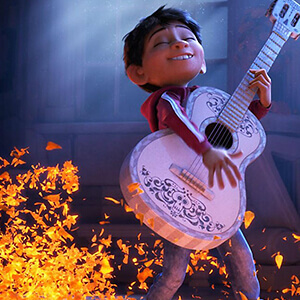 Over the last 20 years, the compounded result of hyper-individualism and the post-modern rejection of metanarrative has made “following your heart” one of our final cultural values (Disney is no stranger to this trope and is in fact one of its strongest transmitters). Coco starts along a similar track, but subtly changes course. In Miguel’s family, an ancestor’s decision to abandon Coco and follow his heart is at the crux of the conflict. Four generations have felt the pain of that choice, and the Land of the Dead offers the possibility of repentance and reconciliation for the ancestor as well as the living family members. Vaguely positive — but empty — philosophies like “following your heart”, “speaking your truth”, or “living your best life now” keep us centered on ourselves and our desires. The truth of Coco, and of what makes us fully human, is that our connections with that which is not us gives us ultimate purpose: connection with our families, our friends, our community, and with our Creator.
Over the last 20 years, the compounded result of hyper-individualism and the post-modern rejection of metanarrative has made “following your heart” one of our final cultural values (Disney is no stranger to this trope and is in fact one of its strongest transmitters). Coco starts along a similar track, but subtly changes course. In Miguel’s family, an ancestor’s decision to abandon Coco and follow his heart is at the crux of the conflict. Four generations have felt the pain of that choice, and the Land of the Dead offers the possibility of repentance and reconciliation for the ancestor as well as the living family members. Vaguely positive — but empty — philosophies like “following your heart”, “speaking your truth”, or “living your best life now” keep us centered on ourselves and our desires. The truth of Coco, and of what makes us fully human, is that our connections with that which is not us gives us ultimate purpose: connection with our families, our friends, our community, and with our Creator.
The act of remembering is powerful: it connects us to stories that shape our past and will shape our futures. Spend two hours immersing yourself in a non-Western tradition that honors its past rather than dismissing it as passé. Then go find a Dia de Los Muertos celebration in a Mexican community near you and remember your own ancestors.

